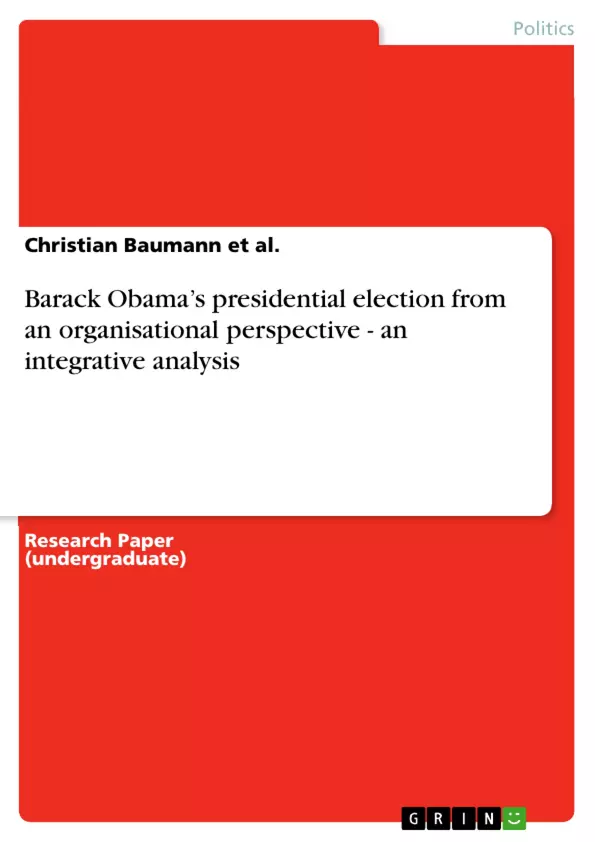1. Introduction
The 4th November 2008 was an important day for the US citizens and the entire world. This day proved for many that the American dream is still possible. For the first time in history an Afro-American candidate became President of the United States of America. Barrack Hussein Obama, a man with an uncommon background, has managed to win the election clearly with 365 electoral votes against his republican counterpart John McCain, who ended his campaign with 173 votes. Who is this man and how did he realize his goal to become president despite the strong competition and the fact that just 40 years ago, racial segregation still was a major problem in the US?
Clearly, he was different compared to his rivals in many ways and this finally accounted for his overwhelming result. The following paper shall identify and analyze these success drivers from an organizational behavior perspective. To what extent did he make use of theories discussed in class, like effective leadership and organizational structure? To begin with, the authors will provide a brief overview in regard to the US American election system, a major reason, why the nation was ready for reconsiderations and change. An initial descriptive discussion of Obama’s election campaign as well as those of his competitors shall serve as a basis for the following integrative analysis, linking both theory and practice in a comparative manner. What made Barack Obama, his campaign and his operations so unique and successful? The subsequent work will provide answers this central question.
[...]
Inhaltsverzeichnis (Table of Contents)
- INTRODUCTION
- SYSTEM ANALYSIS AND THE TIME FOR CHANGE
- THE OBAMA ELECTION CAMPAIGN
- HISTORY & BACKGROUND
- ORGANIZATION & CAMPAIGN STRUCTURE
- HILLARY DIANE RODHAM CLINTON
- HISTORY & BACKGROUND
- ORGANIZATION & CAMPAIGN STRUCTURE
- JOHN SIDNEY MCCAIN III
- HISTORY & BACKGROUND
- ORGANISATION & CAMPAIGN STRUCTURE
- OBAMA'S CAMPAIGN
- LEADERSHIP ANALYSES
Zielsetzung und Themenschwerpunkte (Objectives and Key Themes)
This paper aims to analyze the success of Barack Obama's 2008 presidential election campaign from an organizational behavior perspective. The paper examines how Obama's campaign utilized theories of effective leadership and organizational structure to achieve victory. It also analyzes the US election system and how it influenced Obama's campaign strategy.- The US Election System and its impact on campaigns
- Organizational Structure and Campaign Management
- Leadership Styles and Strategies
- Comparative Analysis of Obama's campaign against his competitors
- Factors contributing to Obama's success
Zusammenfassung der Kapitel (Chapter Summaries)
- The introduction sets the context for the paper, highlighting the significance of Obama's victory and introducing the key themes of organizational behavior and leadership.
- Chapter 2 analyzes the US election system, outlining its historical background, key features, and its influence on campaign strategies. It explains the process of selecting the president and the role of the Electoral College.
- Chapter 3 provides a comprehensive overview of Barack Obama's election campaign, detailing its history, background, organizational structure, and campaign strategies. It explores key factors contributing to the success of his campaign.
- Chapter 4 focuses on the election campaign of Hillary Clinton, presenting a similar analysis of her campaign strategy, organization, and leadership.
- Chapter 5 examines John McCain's presidential campaign, analyzing his campaign strategy, organization, and leadership style in comparison to Obama and Clinton.
Schlüsselwörter (Keywords)
The main keywords for this work include US election system, organizational behavior, leadership styles, campaign management, comparative analysis, Obama, Clinton, McCain, Electoral College, political strategy, success factors. The paper explores these concepts within the context of the 2008 presidential election.- Arbeit zitieren
- Christian Baumann et al. (Autor:in), 2009, Barack Obama’s presidential election from an organisational perspective - an integrative analysis, München, GRIN Verlag, https://www.grin.com/document/134006



